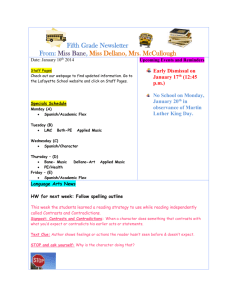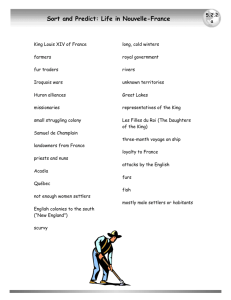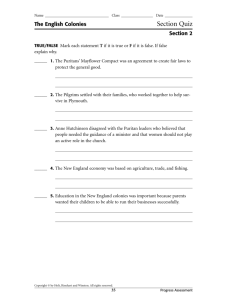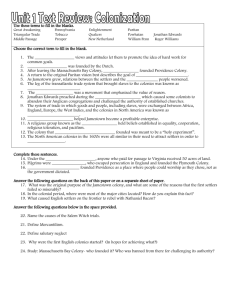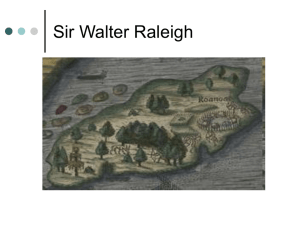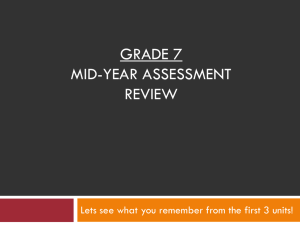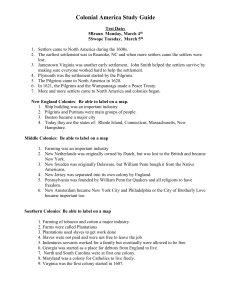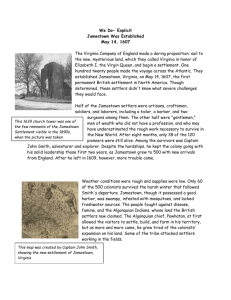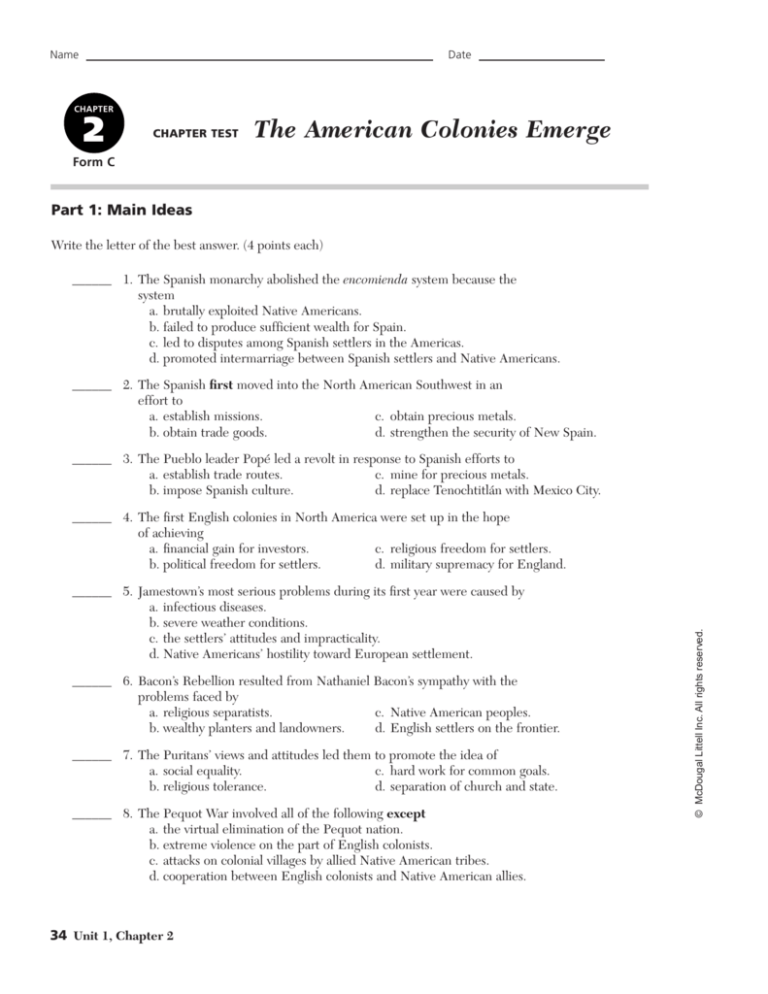
Name
Date
CHAPTER
2
CHAPTER TEST
The American Colonies Emerge
Form C
Part 1: Main Ideas
Write the letter of the best answer. (4 points each)
______ 1. The Spanish monarchy abolished the encomienda system because the
system
a. brutally exploited Native Americans.
b. failed to produce sufficient wealth for Spain.
c. led to disputes among Spanish settlers in the Americas.
d. promoted intermarriage between Spanish settlers and Native Americans.
______ 2. The Spanish first moved into the North American Southwest in an
effort to
a. establish missions.
c. obtain precious metals.
b. obtain trade goods.
d. strengthen the security of New Spain.
______ 3. The Pueblo leader Popé led a revolt in response to Spanish efforts to
a. establish trade routes.
c. mine for precious metals.
b. impose Spanish culture.
d. replace Tenochtitlán with Mexico City.
______ 5. Jamestown’s most serious problems during its first year were caused by
a. infectious diseases.
b. severe weather conditions.
c. the settlers’ attitudes and impracticality.
d. Native Americans’ hostility toward European settlement.
______ 6. Bacon’s Rebellion resulted from Nathaniel Bacon’s sympathy with the
problems faced by
a. religious separatists.
c. Native American peoples.
b. wealthy planters and landowners.
d. English settlers on the frontier.
______ 7. The Puritans’ views and attitudes led them to promote the idea of
a. social equality.
c. hard work for common goals.
b. religious tolerance.
d. separation of church and state.
______ 8. The Pequot War involved all of the following except
a. the virtual elimination of the Pequot nation.
b. extreme violence on the part of English colonists.
c. attacks on colonial villages by allied Native American tribes.
d. cooperation between English colonists and Native American allies.
34 Unit 1, Chapter 2
© McDougal Littell Inc. All rights reserved.
______ 4. The first English colonies in North America were set up in the hope
of achieving
a. financial gain for investors.
c. religious freedom for settlers.
b. political freedom for settlers.
d. military supremacy for England.
Name
Test Form C continued
______ 9. The colony that was founded on principles of social equality and religious tolerance was
a. Plymouth.
c. Pennsylvania.
b. New York.
d. Massachusetts Bay.
______ 10. The North American colonies in the 1600s were all similar in their
a. obligations to investment companies.
b. need to attract settlers in order to prosper.
c. attitudes and behavior toward Native American peoples.
d. social division between a land-owning aristocracy and a landless lower class.
Part 2: Map Skills
NEW
HAMPSHIRE
eH
ari
ak
nt
e O
Boston
NEW YORK
A
L
on
o
ur
12. In the colonial period, what may have been
the easiest way to travel from Baltimore,
Maryland, to Williamsburg, Virginia?
Explain.
T
Albany
RHODE
ISLAND
U
N
L
O
ie
Er
M
e
ak
MASSACHUSETTS
IN
S
Lak
40°
New York
N
11. Was the colony of Massachusetts larger or
smaller than present-day Massachusetts?
Why?
The Thirteen Colonies
LA
CH
IA
Use the map to answer the following questions
in complete sentences. Write on the back of this
paper or on a separate sheet. (4 points each)
A
Baltimore
MARYLAND
MAR
14. Can you tell from this map which country
controlled the land south of Georgia?
Explain.
NEW JERSEY
Philadelphia
PP
A
13. Why might westward expansion have been
difficult for Georgia?
CONNECTICUT
PENNSYLVANIA
DELAWARE
VIRGINIA
Williamsburg
Richmond
T
NORTH CAROLINA
IA
N
M
O
U
N
15. In the colonial period, where were most
of the major cities located? How do you
explain this fact?
PP
A
LA
CH
Wilmington
SOUTH CAROLINA
A
© McDougal Littell Inc. All rights reserved.
A
IN
S
35°
Charles Town
GEORGIA
ATLANTIC
OCEAN
Savannah
30°
N
0
300 Miles
0
500 Kilometers
85°
80°
25°
75°
The American Colonies Emerge 35
Name
The original group of English settlers to reach
Jamestown arrived in May 1607. Groups bringing
additional supplies arrived in January 1608 and
in the fall of 1608. The chart shows the number
of individuals from various occupations in these
three groups. Use the chart to answer the
following questions in complete sentences.
(4 points each)
16. Which occupation had the largest
number of representatives in the original
group that arrived in Jamestown? Which
occupation had the most representatives
in the first and second supply groups?
Occupations of Jamestown Settlers
Occupation (Total)
Group
Councilmen (9)
Original
First Supply
Second Supply
Original
Original
First Supply
Second Supply
Original
Original
First Supply
Original
Original
Original
Original
Original
First Supply
Original
Original
First Supply
Second Supply
Original
Second Supply
First Supply
First Supply
First Supply
First Supply
First Supply
Original
First Supply
First Supply
First Supply
Second Supply
Preacher (1)
Gentlemen (83)
Carpenters (6)
Blacksmiths (2)
Sailor (1)
Barber (1)
Bricklayers (2)
Mason (1)
Tailors (7)
Drummer (1)
Laborers (44)
Boys (6)
17. The Jamestown settlers arrived in
unfamiliar territory to build a community.
Which occupations do you think would
be most useful to the survival of the early
colony?
Fueler (1)
Refiners (4)
Gunner (1)
Perfumer (1)
Apothecaries (2)
Surgeons (2)
Cooper (1)
Tobacco Pipemaker (1)
Tradesmen (14)
18. How might councilmen have been useful in establishing a permanent
settlement?
36 Unit 1, Chapter 2
Number
6
1
2
1
29
28
26
6
1
1
1
1
2
1
1
6
1
12
21
11
4
2
1
4
1
1
2
1
1
1
1
14
© McDougal Littell Inc. All rights reserved.
Part 3: Interpreting Charts
Test Form C continued
Name
Test Form C continued
19. Consider your answers to questions 16 and 17. Do you think the distribution
of occupations among the Jamestown settlers was well suited to the creation of
a new settlement? Explain.
20. Recall from the chapter the purpose of the Virginia Company in sending
settlers to Jamestown. Do you think the company made wise choices in the
people it decided to send? Explain.
Part 4: Extended Response
Answer each of the following questions in a short essay on the back of this paper or on a
separate sheet. (10 points each)
© McDougal Littell Inc. All rights reserved.
21. Compare and contrast the beliefs and actions of the Puritans and the Quakers.
How did the beliefs of these two groups lead them to develop different
societies? Think About:
• attitudes toward Catholic rituals
• the relationship between church and state
• forms of worship
• attitudes toward social hierarchies
22. Compare and contrast how Native Americans and Europeans viewed the
relationship between human beings and land. Could these two viewpoints
have coexisted peacefully in America? Explain your opinion. Think About:
• how the two groups used land
• the issue of ownership
• Native Americans’ and Europeans’ interpretations of land treaties
• how conflicts over land were usually settled between the two groups
The American Colonies Emerge 37

